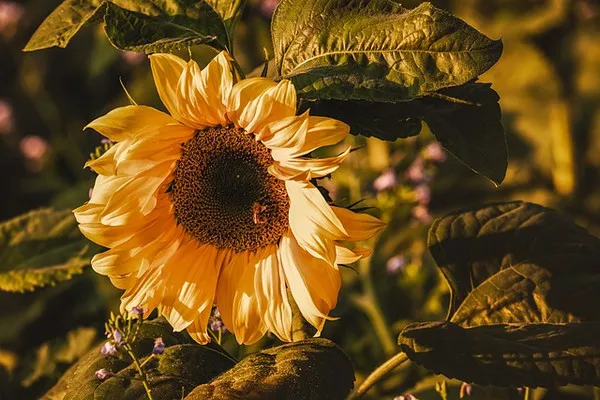Sunflowers, with their vibrant golden petals and towering stems, have long captivated the hearts of admirers around the world. Beyond their aesthetic appeal, these iconic blooms play a crucial role in various ecosystems and agricultural landscapes. One question that often arises among enthusiasts and researchers alike is, “How long do sunflowers live?” This inquiry delves into the intricate life cycle of sunflowers, exploring the factors that influence their longevity and the significance of their existence in the botanical realm.
The Life Cycle of Sunflowers
Understanding the lifespan of sunflowers requires a closer look at their life cycle, which can be divided into several distinct stages: germination, seedling, vegetative growth, flowering, seed development, and senescence.
Germination: The journey begins with the germination of sunflower seeds. These seeds, often planted in well-drained soil, sprout under optimal conditions of moisture and warmth. The germination process typically takes seven to ten days, during which the first signs of life emerge from the soil.
Seedling: As the young sunflower plant continues to grow, it enters the seedling stage. This phase is characterized by the development of the first true leaves, which resemble the mature leaves but are smaller in size. The seedling stage is crucial for the plant’s establishment and sets the foundation for future growth.
Vegetative Growth: The vegetative growth stage is marked by the rapid expansion of the sunflower’s stem and leaves. During this period, the plant focuses on building its structural framework and increasing its overall size. Adequate sunlight, nutrients, and water play pivotal roles in promoting robust vegetative growth.
Flowering: Perhaps the most iconic stage of a sunflower’s life, flowering occurs when the plant is mature enough to produce its trademark blooms. The large, yellow-rayed flowers serve a dual purpose – attracting pollinators and initiating the reproduction process. Sunflowers are known for their heliotropic nature, meaning they follow the sun across the sky, maximizing their exposure to sunlight.
Seed Development: Following successful pollination, the fertilized flowers transform into developing seeds. The center of the sunflower, known as the seed head or capitulum, undergoes significant changes as seeds mature. This phase is crucial for the production of sunflower seeds, which hold both agricultural and commercial value.
Senescence: As with any living organism, sunflowers undergo senescence, the final stage of their life cycle. Senescence is the natural aging process during which the plant ceases active growth and begins to decline. The once-vibrant petals wilt, and the plant redirects its energy toward seed maturation and dispersal.
Factors Influencing Sunflower Lifespan
While the general life cycle of sunflowers provides a framework for their development, several factors influence the overall lifespan of these iconic plants.
Variety: Sunflowers come in various species and cultivars, each with its unique characteristics and adaptations. Some varieties are annuals, completing their life cycle within a single growing season, while others are perennial, capable of regenerating for multiple years.
Environmental Conditions: Sunflowers thrive in well-drained soil and require ample sunlight for optimal growth. Environmental factors such as temperature, humidity, and soil quality can significantly impact a sunflower’s lifespan. Adequate water supply is crucial, especially during the critical stages of germination, flowering, and seed development.
Pests and Diseases: Like any plant, sunflowers are susceptible to pests and diseases that can affect their health and longevity. Common issues include fungal infections, aphids, and caterpillar infestations. Implementing pest management strategies and maintaining overall plant health can mitigate these threats.
Human Intervention: Agricultural practices, cultivation methods, and harvesting techniques employed by humans can influence the lifespan of sunflowers. Proper care, nutrient management, and timely harvesting contribute to healthier plants and a more extended lifespan.
Significance of Sunflowers
Beyond their intrinsic beauty, sunflowers hold immense ecological and economic importance. In agricultural landscapes, sunflowers serve as valuable crops, providing oil-rich seeds used in cooking oil, snacks, and bird feed. Their ability to absorb heavy metals from the soil has also led to their use in phytoremediation projects, contributing to environmental cleanup efforts.
In natural ecosystems, sunflowers play a critical role in supporting biodiversity. Their large, vibrant flowers attract a diverse array of pollinators, including bees, butterflies, and birds, contributing to the overall health of ecosystems.
See Also: Can You Eat Sunflower Leaves?A Culinary Adventure
Conclusion
The lifespan of sunflowers, though varying among different species and cultivars, is a testament to the intricate dance of nature. From the humble beginnings of germination to the grand finale of senescence, sunflowers navigate the stages of life with resilience and purpose. As we unravel the mysteries of their existence, we gain a deeper appreciation for these botanical wonders and the role they play in our agricultural, ecological, and aesthetic tapestry. Whether adorning fields or gracing garden landscapes, sunflowers continue to enchant and inspire, reminding us of the enduring beauty inherent in the circle of life.


